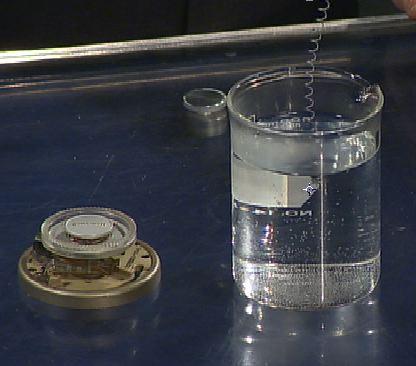Can a piece of metal have a “memory?” Yes, if themetal is a special alloy of nickel and titanium. It’s calledMemory Metal, and the uses for this material go far beyondtoday’s amazing demonstration.

Experiment
If you stretch an ordinary metal spring to its limit, there’s no way for the spring to recoil. However, a spring made from Memory Metal can easily recoil when heated to about 120 degrees F (50 degrees C). Memory alloys can be compared with rubber bands. They can be stretched considerably without being deformed. When a spring made of memory metal is stretched, the crystal lattices change shape, but they aren’t destroyed. When the spring is heated to a certain temperature, the atoms in the crystal lattices re-assume their original order and the spring recoils. In other words, the spring “remembers” the shape it had before it was stretched.
Additional Info
Broken bones can be mended with shape memory alloys. The alloy plate has a memory transfer temperature that is close to body temperature and is attached to both ends of the broken bone. From body heat, the plate wants to contract and retain its original shape, therefore exerting a compression force on the broken bone at the place of fracture. After the bone has healed, the plate continues exerting the compressive force and aids in strengthening during rehabilitation. Memory metals also apply to hip replacements, considering the high level of super-elasticity.
For clogged blood vessels, an alloy tube is crushed and inserted into the clogged veins. The memory metal has a memory transfer temperature close to body heat, so the memory metal expands to open the clogged arteries.
Used for braces and dental arch wires, memory alloys maintain their shape since they are at a constant temperature, and, because of the super elasticity of the memory metal, the wires retain their original shape after stress has been applied and removed.
Anti-scalding protection – Temperature selection and control system for baths and showers: Memory metals can be designed to restrict water flow by reacting at different temperatures, which is important to prevent scalding. Memory metals will also let the water flow resume when it has cooled down to a certain temperature.
Lines that carry highly flammable and toxic fluids and gases must have a great amount of control to prevent catastrophic events. Systems can be programmed with memory metals to immediately shut down in the presence of increased heat. This can greatly decrease devastating problems in industries that involve petrochemicals, semiconductors, pharmaceuticals, and large oil and gas boilers.
In certain commercials, eyeglass companies demonstrate eyeglass frames that can be bent back and forth and retain their shape. These frames are made from memory metals as well and demonstrate super-elasticity.
